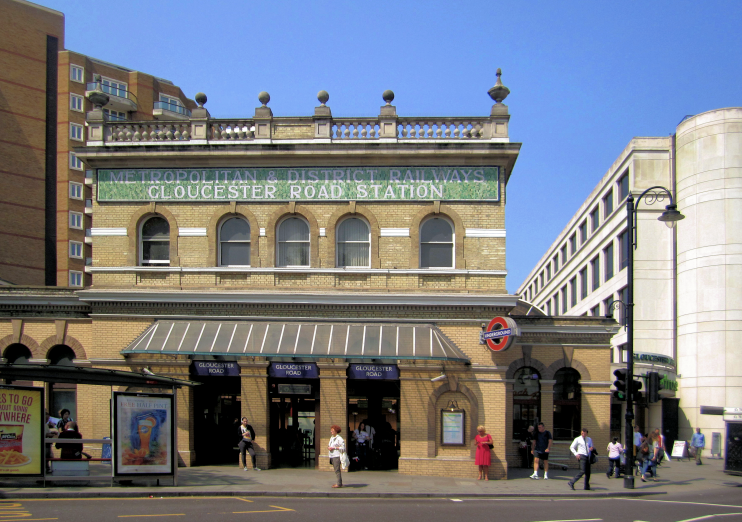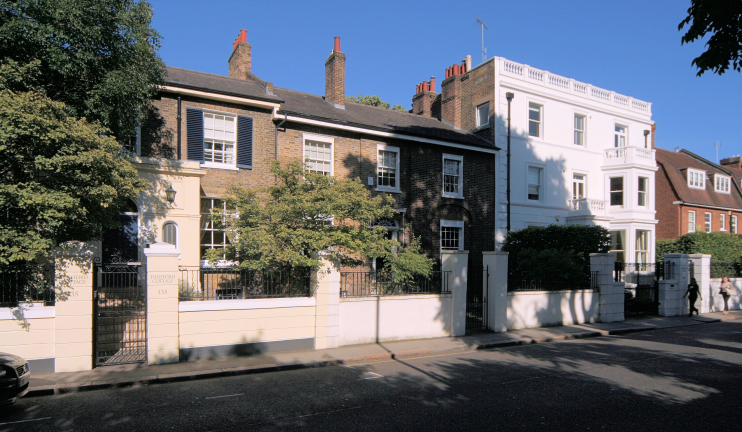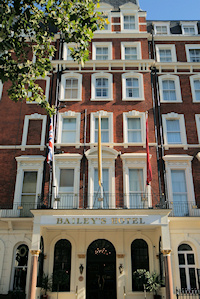Gloucester Road
Gloucester Road, Kensington & Chelsea
A commercial street and hotel zone running northward from South Kensington towards Kensington Gardens

From the early 17th century this was Hogs Moor or Hogmire Lane and it was the site of an ultimately unsuccessful pleasure garden (and for a while a pick-your-own fruit and flower farm) in the late 18th century. At that time most of the vicinity was filled with nurseries and market gardens.
George III’s sister-in law Maria, Duchess of Gloucester built herself a house called Villa Maria (later Orford Lodge) on part of the pleasure garden’s site in 1805, and she died there two years later. The politician George Canning bought the property in 1809 and retained it until 1825. The house (latterly called Gloucester Lodge) stood in extensive grounds close to what is now the south-east corner of Gloucester Road’s junction with Cromwell Road.
Much of the surrounding area was built up in the second quarter of the 19th century or soon afterwards. The more significant projects included:
- To the south-east, the modest Lee estate of 1825 (including the well-preserved properties at 135 and 137 Gloucester Road – shown on the left of the photograph below)
- To the north-west, Kensington New Town between 1837 and 1843 (including numbers 2 to 32 Gloucester Road and the Gloucester Arms at No.34, all now grade II listed)
- To the south-west, Hereford Square in the mid-1840s
- To the north-east, Kensington Gate (originally called Gloucester Square) from 1850

Gloucester Lodge was demolished shortly after 1851, by which time almost everyone had stopped calling the thoroughfare Hogmire Lane and started calling it Gloucester Road – as had been suggested by the Kensington Turnpike Trustees soon after the duchess had died.
From 1862 two developer-builders began laying out Cornwall Gardens on land that had belonged to members of the Broadwood piano-making family since the start of the century. The street was named in honour of the Prince of Wales (also Duke of Cornwall), who came of age in November 1862. Cornwall Gardens quickly became popular with high-ranking administrators, lawyers and soldiers, especially those who had recently returned from colonial duties in India. Kynance Place and Mews were created at the same time, originally as St George’s Place and Cornwall Mews.
Palace Gate was also laid out in the 1860s, forking left at the north end of Gloucester Road, which had hitherto forked right and continued up to Kensington Road.
Some grand Italianate terraces were built on Gloucester Road itself during this period. They were later converted to flats or hotels, or replaced by mansion blocks or rows of shops with flats above.
The cosy, ornate church of St Stephen was consecrated in 1867. In the following year the Metropolitan Railway opened a branch line from Edgware Road to Brompton (Gloucester Road), as the station was originally called. John Fowler was the station’s (highly paid) engineer and architect. District Railway trains also began serving Brompton a few months after it had opened.
Part of Kensington’s Alexander estate, the west-central section of Gloucester Road and its hinterland began to fill with high-class housing as soon as developers knew the railway was coming. From an early stage, it was intended to build a substantial hotel on the south corner of Gloucester Road and Courtfield Road. The entrepreneurial son of a Norfolk farmer, James Bailey soon became involved in the project and the main part of his hotel was completed in 1876, though it was subsequently extended in several stages.
Designed by Leslie Green, Gloucester Road Piccadilly line station opened in 1906, next door to the original station on the corner of Courtfield Road. (See Wikipedia’s article for a full account of the station’s complicated history.)
Kensington New Town’s St George’s Terrace was demolished in 1907 and replaced by St George’s Court (42–72 Gloucester Road), which has shops at street level and flamboyant redbrick and flats above, with stone dressings. The architect was Paul Hoffman, who was responsible for several large commercial and residential blocks in Kensington and the West End. Incompatibly, the Survey of London (ed. Hermione Hobhouse) calls St George’s Court ‘dowdy’ while The Buildings of England (ed. Nikolaus Pevsner) calls it ‘jubilant’.

Sections of Gloucester Road were redeveloped at regular intervals after the Second World War, beginning with the replacement of bomb-damaged properties. This has resulted in some architectural inconsistency, especially among the houses towards the southern end of the road.
In the early 1970s Bailey’s Hotel was threatened with demolition, which the Royal Borough of Kensington and Chelsea creditably resisted. The Bailey’s Hotel, as it now pretentiously called, is presently operated by Millennium Hotels.
In 1989 a large shopping and office complex was built behind Gloucester Road station, spanning the District and Circle line tracks. As part of the development, the twin stations were remodelled internally to share a single entrance, which is shown in the photo at the top.* The redundant Piccadilly line station building was divided into retail units.
In addition to its hotels, Gloucester Road has many short-stay apartments and studio flats, while a plentiful supply of bars and cafés caters to both tourists and residents. The locality’s best-known restaurant is probably the Bombay Brasserie, which opened in 1982 in a corner of Bailey’s Hotel that had once been the site of its stables.
Long-term residents of Gloucester Road and its neighbouring streets tend to be affluent and in good health. Many are employed in financial and insurance activities, often working long hours. Like other parts of Kensington, demographic data for this locality bears little resemblance to the picture for London as a whole. To take one example from the 2011 census, non-British residents were more likely to have been born in France or the United States than any other country.
The author JM Barrie lived at 133 Gloucester Road between 1895 and 1902, the period in which he conceived the story of Peter Pan.
In his Literary Guide to London, Ed Glinert calls TS Eliot ‘the Pope of Gloucester Road’ in an allusion to the poet’s 25 years as warden of St Stephen’s church. Eliot lived in nearby Grenville Place from 1933 to 1940.
